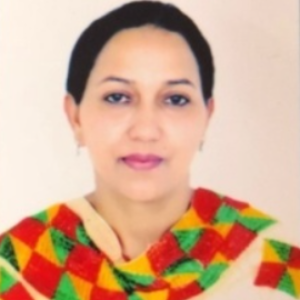Title : Clinico- epidemiological study and therapeutic outcomes of cutaneous leishmaniasis: An emerging disease in North India
Abstract:
Background: An increasing number of patients with cutaneous leishmaniasis (CL) are reporting to tertiary care centers in Jammu and Kashmir, an area that has previously been non-endemic for this disease. This merits consideration of CL as a major health problem of considerable epidemiological importance. The aims of this study were firstly to describe the clinico-epidemiological profile, therapeutic characteristics, and outcomes of patients with CL and secondly to highlight this union territory as a new focus of endemicity for CL. Methods: A two-center hospital-based prospective cohort study was conducted at two tertiary care hospitals in Jammu and Kashmir over a period of 10 years (July 2009 to June 19). All patients presenting to the outpatient departments with lesions suggestive of CL were enrolled for the purpose of this study. Demographic data were recorded on a proforma questionnaire, along with a detailed history and the results of a meticulous examination. Patients diagnosed with CL based on clinical criteria were subjected to slit skin smear (SSS) and histopathological examination for confirmation of the diagnosis. An intralesional pentavalent antimonial, sodium stibogluconate (SSG), was administered at a dose of 0.5 mL/ cm2 (100 mg/mL solution) three times weekly to those patients with smaller lesions, and intravenously or intramuscularly at a dose of 20 mg/kg/day to those with larger lesions. The response to treatment was assessed by total re-epithelialization of the lesion and an absence of infiltration and erythema, with or without scarring. Treatment was given until complete resolution of the lesions or for a maximum duration of 10 weeks when given intralesionally and 3 weeks when given systemically. Clinical follow-up was performed twice weekly for the first 2 months and monthly thereafter. The final response to treatment was assessed at 6 months. Results: The study included a total of 1300 patients with a mean age of 26.7 18.5 years. The mean duration of the disease was 28.52 13.5 weeks, ranging from 8 to 64 weeks. Lesions were noted mainly on exposed parts of the body, with the face being the most commonly affected site (89.00%). Noduloulcerative plaques were the predominant lesion type observed (73.92%). The presence of Leishman– Donovan bodies could be demonstrated on SSS and histopathology in 60.69% and 39.54% of patients, respectively. The presence of a recognizable histological pattern conforming to CL and a response to a therapeutic trial of SSG was considered to be confirmatory in the remaining patients. Complete cure was achieved in 84.23% of cases during the study period. Single lesions were more likely to respond to treatment as compared to multiple lesions. The route of administration did not have any significant impact on the final outcome. Conclusions: With the disease showing an escalating trend in Jammu and Kashmir,the possibility of a new focus of endemicity and its impact on public health need to be contemplated, and appropriate measures should be initiated to contain its spread.
What will audience learn from your presentation?
(Try to list 3-5 specific items)
- This study aimed to draw attention to Jammu and Kashmir as a new focus of endemicity, which will be of considerable public health interest.
- Awareness of the disease and recognition of the varied clinical presentations is important for prompt diagnosis.
- A comprehensive and exhaustive clinicoepidemiological profile of CL is presented to guide further studies in this direction, especially those discerning predominant Leishmania species, disease reservoirs, and vector control strategies in the region.
Explain how the audience will be able to use what they learn?
- Increase in the incidence, extension to previously non-endemic areas and varied clinical presentation underlines the importance of high index of suspicion among clinicians
- Awareness among health workers regarding the disease and recognition among the differential diagnosis of asymptomatic/ulcerated papules and plaques is important for correct diagnosis, especially in non-endemic areas
- In resource poor settings, confirmation of diagnosis based on Epidemiological criteria, Clinical criteria, Giemsa stained slit skin smears (L.D bodies), and H and E stained skin biopsy sections should be sufficient.
- Different treatment options available must be based on leishmania species, geographic regions and clinical presentation
- Reports about spontaneous resolution and effectiveness of local therapies have resulted in local therapies being considered as first line treatments in most cases.
- Intralesional treatment may be considered as a preferential form of treatment for OW CL, thus evading the toxicity associated with systemic administration of drugs
How will this help the audience in their job? Is this research that other faculty could use to expand their research or teaching? Does this provide a practical solution to a problem that could simplify or make a designer’s job more efficient? Will it improve the accuracy of a design, or provide new information to assist in a design problem? List all other benefits.
- Studies to improve diagnostic algorithms for CL, including identification of vector and vertebrate host(s), and the diversity of leishmania species responsible for disease are warranted
- Funding by world health agencies to carry out research for species identification (DNA based tests) in newly identified endemic foci for the disease.
- Non-availability of drugs is a major issue in developing countries. Antimonials are still one of the most effective modalities to treat cutaneous leishmaniasis, if given under supervision and proper monitoring carried out. World health agencies need to give attention to the disease and make drugs available (on the lines of MDT in leprosy) especially in resource poor countries.



